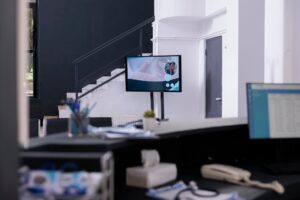you’re shopping online for a cool new toy or a pair of shoes. You can’t touch or hold the product, so how do you know what it looks like from all sides? That’s where 3D product visualization comes in! It lets you see a product in a 3D (three-dimensional) format, which means you can look at it from all angles—front, back, top, and bottom.
Think of 3D product visualization like a virtual model of an object that you can spin around and inspect, just like you would with a real object in your hands.
Why is 3D Product Visualization Important?
- Better Shopping Experience: You can see every detail of the product before buying it.
- Reduces Returns: When people know exactly what they’re buying, they’re less likely to return it.
- Interactive: You can zoom in, rotate, and sometimes even change colors or features in real time.
How Does 3D Product Visualization Work?
3D product visualization involves creating a digital version of an object. Here’s how it’s done:
- 3D Modeling: A 3D artist creates a virtual version of the product using special software like Blender or SketchUp.
- Texturing: The surface of the 3D model is given color and texture to make it look real.
- Lighting: Lights are added to make the model look like it’s in a natural environment.
- Rendering: This is the final step, where the 3D model is turned into an image or animation that can be viewed on a website or in a video.
Tools Used for 3D Product Visualization
Here are some popular tools people use to create 3D product visuals:
| Tool Name | What It Does | Suitable For |
|---|---|---|
| Blender | Free, open-source 3D modeling software | Beginners & Experts |
| Autodesk Maya | High-end 3D modeling and animation tool | Professional use |
| SketchUp | Easy-to-use 3D modeling tool | Beginners |
| Adobe Dimension | 3D design and visualization tool | Graphic designers |
You see 3D product visualization everywhere! Here are some examples:
Online Stores: Websites like Amazon use 3D visuals so you can rotate products.
Furniture Companies: Companies like IKEA let you see furniture in 3D so you can imagine it in your room.
Video Games: The characters and objects in your favorite games are all made using 3D visualization.
Advantages of 3D Product Visualization
Here are some cool things about 3D product visualization:
- Realistic Views: You get to see what the product really looks like, which is way better than just a flat picture.
- Interactive Experience: You can move, rotate, and zoom in on the product.
- Customization: Some websites even let you change the color, size, or features of the product in real-time!
- Saves Time and Money: Instead of making real-life prototypes, companies can make digital versions to show their customers.
Disadvantages of 3D Product Visualization
There are a few challenges with 3D product visualization:
- Expensive Software: Some of the software needed can be costly.
- Time-Consuming: It takes time to create detailed 3D models.
- Learning Curve: You need to learn how to use 3D modeling software, which can be tricky.
How 3D Visualization Works?
Let’s say you’re designing a new shoe. Here’s how 3D visualization would help:
- Step 1: A 3D artist creates the shape of the shoe using a tool like Blender.
- Step 2: The artist adds details like texture for the fabric and color to make the shoe look real.
- Step 3: Lighting is added to the scene to show how the shoe looks in different environments.
- Step 4: The final 3D model is put on the website where users can rotate it and check it out from every angle.
How 3D Visualization Helps Companies
- Faster Production: Companies don’t need to create multiple real-life models of a product. They can create one digital model and use it to test out different looks.
- Marketing: Companies can use 3D visuals in their ads, giving customers a clear idea of what they’re buying.
- Prototyping: Before making a real product, companies can test its design using 3D models.
Future of 3D Product Visualization
3D visualization is getting even cooler with new technologies. Here are some trends:
- Augmented Reality (AR): You can place 3D models of products in your real world using a phone or AR glasses. Imagine putting a 3D sofa in your living room to see how it fits!
- Virtual Reality (VR): With VR headsets, you can explore 3D products like you’re standing next to them in a virtual store.

Final Thoughts
3D product visualization is like having a virtual version of a product you can see from all angles, making online shopping more fun and informative. It helps both customers and businesses by showing products in a way that feels real. Plus, with new technologies like AR and VR, the future of 3D visualization is looking even more exciting!
read more blog at findtec








